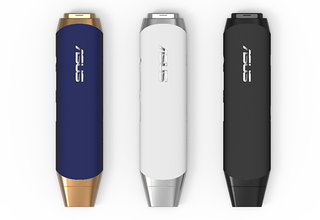Asus Announces VivoStick: Cherry Trail Atom-Powered Compute Stick

More compute sticks have landed.
Back at CES this year, Intel announced Compute Stick. This entire system on a stick plugs into a display via HDMI and runs either Windows or Ubuntu. It was designed as an inexpensive x86 alternative to ARM-based Android-on-a-stick PCs.
We got a chance to test one out back in April and found it was suitable only for lightweight computing tasks, but having a full PC in such a small form factor for such a low price ($150) was still impressive. However, its 22nm Bay Trail Atom Z3735F was underpowered, especially on the graphics front, and it ran hot enough to require the Stick to have active cooling with a fan. Also, its 32 GB of storage was very limiting for a device running a full version of Windows.
At IFA, Asus announced that it is getting into this market, too, and is releasing its version of this tiny form-factor, the VivoStick PC. Asus's offering improves in a number of ways over Intel's model by using a newer Cherry Trail SoC, and it also runs Windows 10. However, it still does have a few of the compromises that affected the Intel Stick.
Specifications
| Product | Asus VivoStick |
|---|---|
| SoC | Intel Cherry Trail x5-Z8300 (?) |
| CPU | 1.44 GHz (1.84 GHz burst) quad-core (?) |
| GPU | Intel HD Graphics (Gen 8, 200 - 500 MHz, 12 execution units) |
| Memory | 2 GB eMCP |
| Storage | 32 GB eMCP |
| Connectivity | 802.11 b/g/n, BlueTooth 4.0 |
| IO | 1 x HDMI, 1 x USB 3.0, 1 x USB 2.0,1 x HD Audio Jack (Mic/Headphone combo), 1 x micro USB |
| Dimensions & Weight | 138 x 34 x 15 mm, 70g |
| OS | Windows 10 Home |
The Cherry Trail SoC is certainly a big step up from the Compute Stick's Bay Trail SoC. It is a 14nm chip, so the VivoStick probably has no need for active cooling. Also, the Intel HD GPU of Cherry Trail should be significantly faster, up to 50 percent, which will make a big difference in a number of applications.
Asus did not make it clear, though, as to which specific Cherry Trail chip it will be using. It is likely to be the base model, the x5-Z8300, for power and heat reasons, though it could possibly use the more powerful x5-Z8500 found in the Asus Transformer Book T100, which has a higher burst clock speed and higher-clocked GPU.
The VivoStick also has two USB ports, one USB 2.0 and one USB 3.0, versus the single USB 2.0 port of the Intel stick. Bluetooth is on board to wirelessly connect to a mouse and keyboard. It comes with Windows 10 instead of Windows 8.1 with Bing, which is installed on the Intel unit. Lastly, the VivoStick is a little more attractive – it comes in different colors and has a cap to protect its HDMI connector.
Stay on the Cutting Edge
Join the experts who read Tom's Hardware for the inside track on enthusiast PC tech news — and have for over 25 years. We'll send breaking news and in-depth reviews of CPUs, GPUs, AI, maker hardware and more straight to your inbox.

What isn't so great, though, it that Asus's offering doesn't have any more storage than the Intel model; it's still just 32 GB. Such a small amount of storage is very limiting for a full Windows PC, so don't expect to be installing very many applications on this computer. Further, unlike the Intel stick, the VivoStick does not have a microSD slot, so you can't add capacity.
In closing, while the VivoStick does look like a pretty good device for this category and bests Intel's initial offering, unfortunately for Asus, Intel just announced a new version that will use a Skylake Core m chip. This should handily outperform the VivoStick, though we don't expect to see it in the near future, and the jump up to Core architecture will probably mean a big jump in price, too.
Similar compute stick-like offerings were earlier announced by Lenovo (Ideacentre Stick) and Archos (yeah, Archos, how about that).
The VivoStick will be selling for $130, but no information on availability was released.
-
Daniel Ladishew It seems like with 2 USB ports, it would be fairly simple to add a portable USB drive for extra storage if needed. That being said, most people are going to use these for simple internetting and streaming.Reply -
dstarr3 I usually don't care about aesthetics, but I am glad that these look better than Intel's efforts.Reply -
ZolaIII As much as I know gpu should be around 2.2x faster. The rest is not a step up from previous generation & there are even some steps back in dynamic frequency handling. I don't believe it will be a big step up neither in power consumption nor heat dispersion. I am certain it won't be capable to handle Win 10 satisfying (Linux probably culd).Reply -
WyomingKnott I may have found my HTPC for music! Since I use a USB DAC, I just plug one of these into it, with a 128 GB thumb drive in the other slot.Reply
Most Popular


